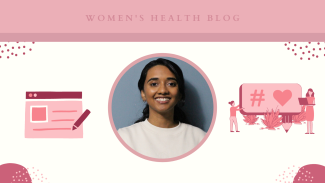Interviewee: Arrthy Thayaparan, B.Sc., M.J., University of British Columbia |
Authors/Editors: Negin Nia & Romina Garcia de leon (Blog Co-coordinators).
Published: May 20th, 2022.
The Women’s Health Research Cluster (WHRC) blog started back in 2020. The blog aimed to showcase work by women and gender-diverse people wanting to make a change in the women’s health field.
We spoke to Arrthy Thayaparan, one of the first WHRC Blog Co-coordinators, about her experience working for the blog. She shares what got her initially interested in pursuing work in women’s health.
Why did you decide to pursue work as a Blog Co-coordinator?
I have an academic background in both science and journalism. Therefore, I was seeking a job that would allow me to continue to learn and share stories in the science and health realm. When I found out about the blog through the UBC Work Learn website, I knew it was the perfect fit. I ended up applying to every single option available with the WHRC, but glad I was selected as a Blog Co-coordinator as it was a much better fit to help finetune my writing skills.
As a lover of science who was starting her journalism career, the WHRC was just a great way to help me learn and expand on those essential communication skills. It also let me stay in touch with the world of academia. I got to work with a thoughtful and energetic team, while also peering behind the scenes of a research cluster taking on valuable work in the field.
Out of all the scientific fields you were exposed to, why women’s health?
I got into science journalism because I became aware of the lack of science-trained journalists who knew the field and could communicate it to a general audience. From there, I began to realize that women’s health is underrepresented, especially in the media.
For example, there were a lot of worries and myths about fertility, pregnancy, and vaccinations during the start of the COVID-19 pandemic. So, the WHRC prioritized this in our blog topics and got the conversation going. That realization and effort to engage worked out to our benefit since the pregnancy vaccination blogs are some of our most widely read blogs to this day.
What impact do you hope the blog will have in the field of women’s health going forward?
When the blog first started it was pretty small and we didn't have too many readers or much engagement. Now, we can see how the work that we've done over the past two years has grown. Recently, we were voted the 9th top Women’s Health blog by FeedSpot.
Seeing that growth in just two years was motivating for everyone on the team. I think with that momentum, the blog could go on to become a staple in women’s health awareness and education. This is especially true with how diverse the WHRC members are both globally and knowledge-wise.
Do you see yourself integrating women’s health into your future roles?
Oh, absolutely! I think working here has opened my eyes to so many topics within the field of science. I’ve always associated my best journalistic work with experts or researchers I have interviewed from the WHRC. For example, Dr. Jade Boyd was a huge help for one of my biggest stories last year on understanding overdose reversals in B.C. I covered what impact that had on frontline workers of the overdose crisis. I’ll always keep coming back to the WHRC and the blog to keep myself up to date and to stay connected.
Is there anything else you would like to mention?
I’m grateful to everyone at the WHRC for having me on, the writers of the blogs for their passion, and the readers for allowing us to continue sharing this essential work. I’m especially thankful to Alex Lukey and Negin Nia, my blog co-coordinators, for bearing with me when things got stressful with school and supporting each other with the work.
Also, I don’t think enough credit is given to the support we receive from Katherine Moore, Director of Operations & Strategic Initiatives, and Liisa Galea, Cluster Lead. No matter what crazy idea we brought forward, like the Behind the Science series or creating a Medium page, they were always on board and excited. None of this would be possible without their vision or passion for knowledge translation and women’s health. I’m beyond grateful to have had the opportunity to work with them.
Other than that, I’m excited to see how the blog continues to grow, and I hope that one day I can write for the blog or about the blog.
How can people reach you?
People can follow me on Twitter (@ArrthyT) to keep up with my work. Feel free to message me to talk about potential stories or anything science-related.
